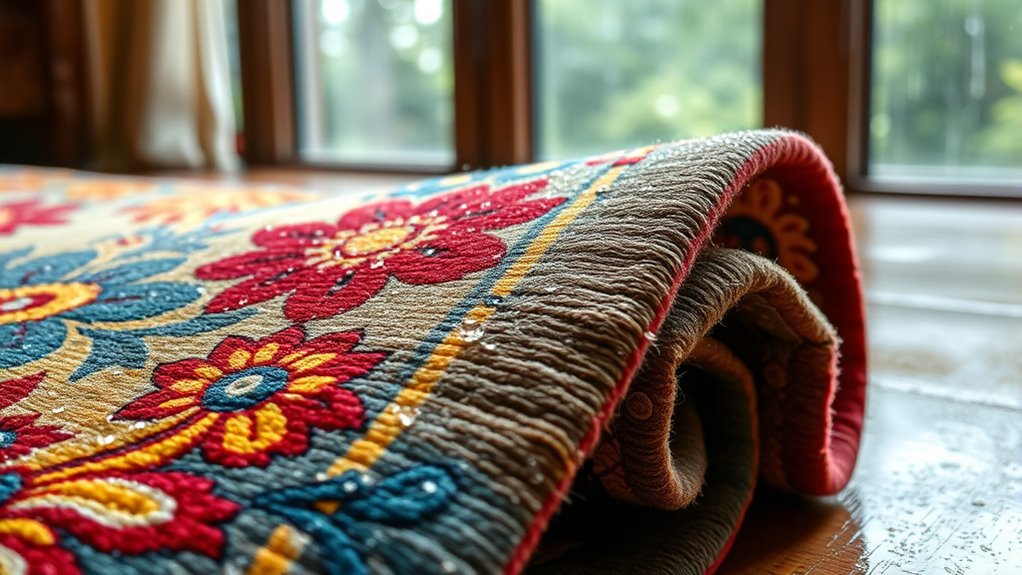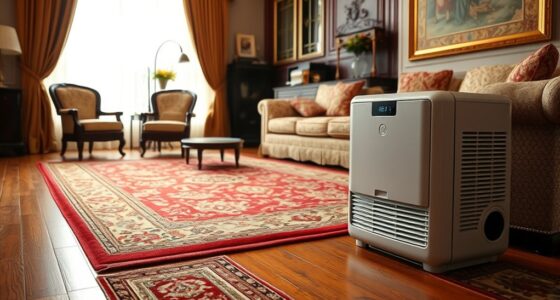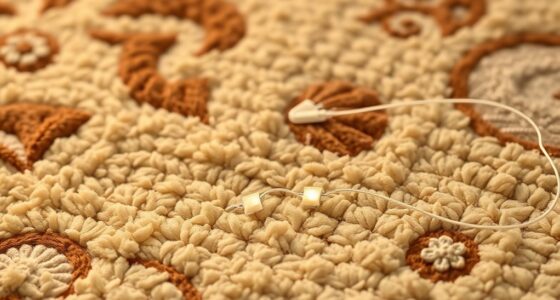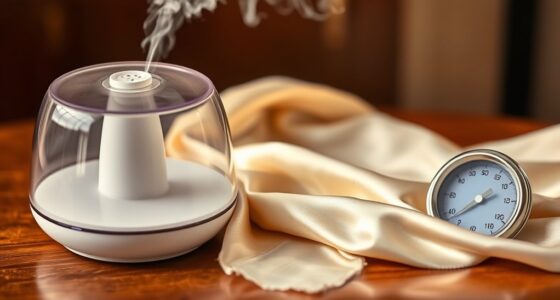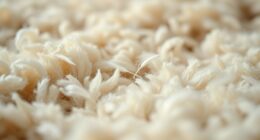During humid monsoon seasons, protect your rugs by keeping them dry, well-ventilated, and away from damp areas. Elevate rugs on moisture-resistant pads, avoid direct sunlight, and maintain proper airflow to prevent mold and mildew. Regularly clean and dry your rugs thoroughly, and consider using dehumidifiers or moisture absorbers to control indoor humidity. Choosing durable, moisture-resistant materials also helps preserve your rugs longer. Learn expert tips to keep your rugs safe and pristine throughout monsoon months.
Key Takeaways
- Elevate rugs on moisture-resistant pads to improve airflow and prevent mold during humid monsoon seasons.
- Regularly clean and thoroughly dry rugs using fans or dehumidifiers to prevent mold, mildew, and odor buildup.
- Keep rugs away from damp areas like basements and water-prone zones to minimize moisture absorption.
- Choose durable, moisture-resistant materials like wool or nylon and avoid natural fibers prone to mold.
- Ensure proper ventilation in rooms and avoid direct sunlight to protect rug colors and promote drying.
Understanding the Impact of Humidity on Rugs
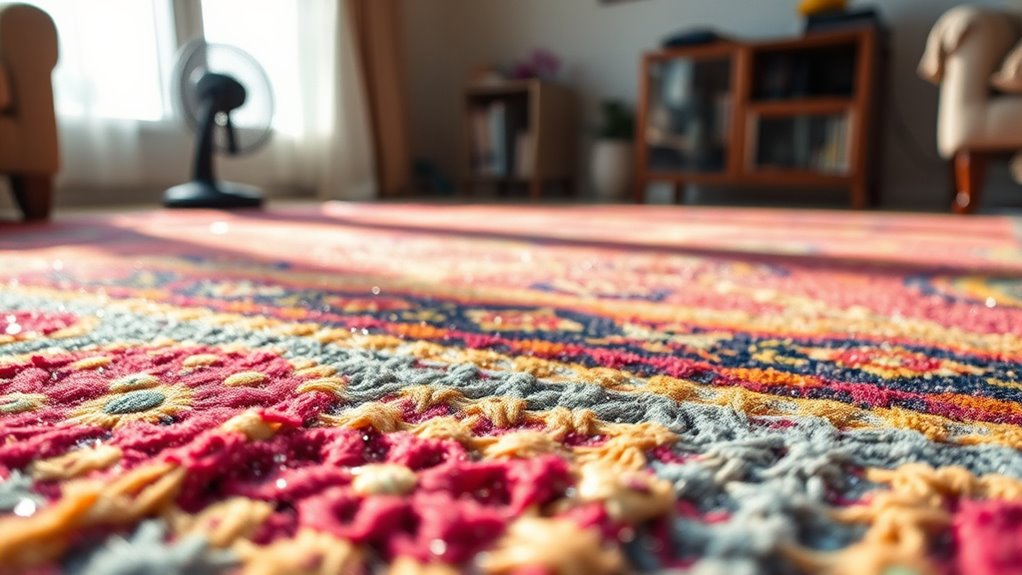
During the monsoon season, high humidity levels can profoundly affect your rugs. Different fiber types respond differently to humidity effects. Natural fibers like wool and cotton tend to absorb moisture quickly, making them prone to mold, mildew, and odors if not properly cared for. Synthetic fibers, such as nylon or polyester, are more resistant but can still suffer from dampness that leads to odor buildup or fiber deterioration over time. Excess moisture causes fibers to swell, weakening their structure and increasing the risk of damage. Additionally, high humidity promotes dust mites and bacteria growth, which can stain or degrade your rug. Understanding how humidity affects various fiber types helps you take proactive steps to protect your rugs during the monsoon, ensuring they stay clean and in good condition. Being aware of fiber responses can help you choose appropriate cleaning and drying methods to prevent long-term damage. Proper ventilation and dehumidification can significantly reduce moisture accumulation in your home, safeguarding your rugs and other textiles. Incorporating humidity control measures can further enhance the preservation of your rugs and keep your living space healthier.
Regular Cleaning and Maintenance Practices
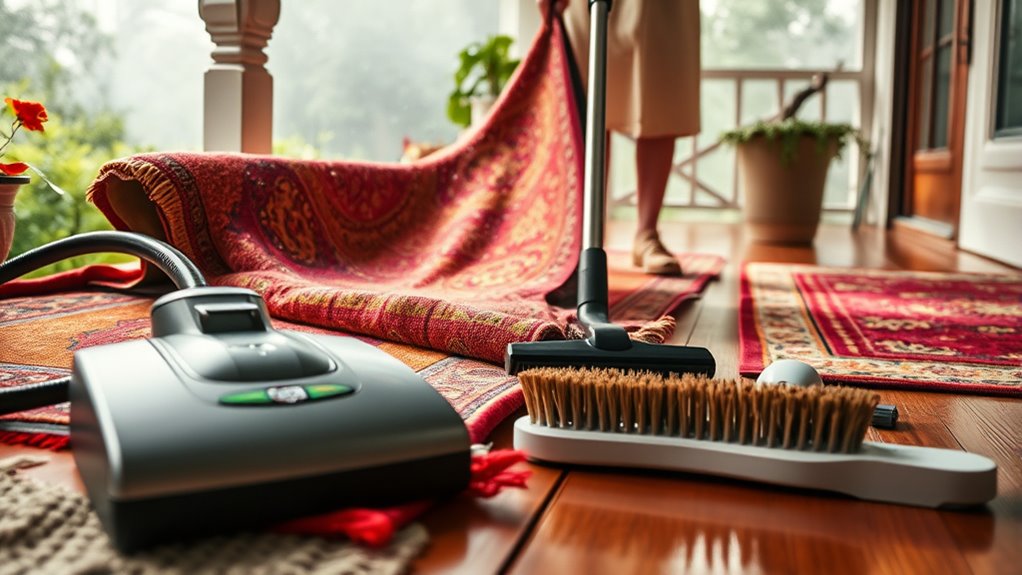
To keep your belongings in top shape during the monsoon, you need to focus on regular cleaning. Make sure to remove dirt consistently to prevent buildup and damage. Additionally, use proper drying techniques to guarantee everything dries thoroughly and stays mold-free. Being aware of SWIFT/BIC codes can also help you conduct secure financial transactions when needed. Proper fatherhood practices, including attentive care and support, can serve as a reminder to nurture and protect your belongings during humid summers. Incorporating self watering plant pots into your gardening routine can also help maintain healthy plants and prevent overwatering issues. Using ergonomic furniture can improve comfort while cleaning and maintaining your space, reducing strain during tedious tasks. Implementing proper car maintenance routines ensures your vehicle remains protected from humidity-related issues.
Consistent Dirt Removal
Regular cleaning is vital to keep your home free of dirt and debris, especially during the monsoon season when moisture can accelerate grime buildup. To prevent dirt accumulation on your rugs, make it a habit to vacuum regularly, focusing on high-traffic areas. This not only removes surface dust but also prevents dust from settling deep into the fibers. Consistent dirt removal helps maintain your rug’s appearance and prolongs its lifespan. By staying diligent with cleaning routines, you effectively reduce dust buildup, which is indispensable for dust prevention in humid weather. Keep a schedule and don’t skip routine vacuuming, especially after rainy days. Quick and frequent cleanings will ensure your rugs stay fresh, clean, and protected from the damaging effects of dirt and moisture during the monsoon season. Additionally, adopting data-driven strategies can help you identify the most effective cleaning frequency tailored to your environment. Incorporating proper care and maintenance practices can further enhance your rug’s resilience against humidity-related damage, including humidity control techniques which are crucial in humid summers. Regular vacuuming also benefits from using appropriate vacuum cleaner attachments such as upholstery brushes and crevice tools to reach all areas effectively. Implementing tuning methods, similar to those used in BMW tuning, can optimize your cleaning tools for maximum efficiency and effectiveness.
Proper Drying Techniques
After thoroughly removing dirt and debris, focus on proper drying techniques to prevent mold and mildew growth. Spread your rug in a well-ventilated area, avoiding direct sunlight to prevent color fading. Use fans or dehumidifiers to speed up the drying process and reduce moisture buildup. Guarantee the rug is completely dry before storing or placing it back on the floor, as residual dampness can cause unpleasant odors. Proper drying not only controls odors but also preserves the rug’s vibrancy by preventing color fading caused by prolonged moisture exposure. Regularly inspecting your rug during drying helps identify any damp spots. Additionally, using energy monitoring features on appliances can help reduce utility bills during your cleaning routine, ensuring efficient drying without excess energy consumption. Following these techniques keeps your rug fresh, odor-free, and vibrant throughout the humid monsoon season.
Proper Placement and Ventilation Tips
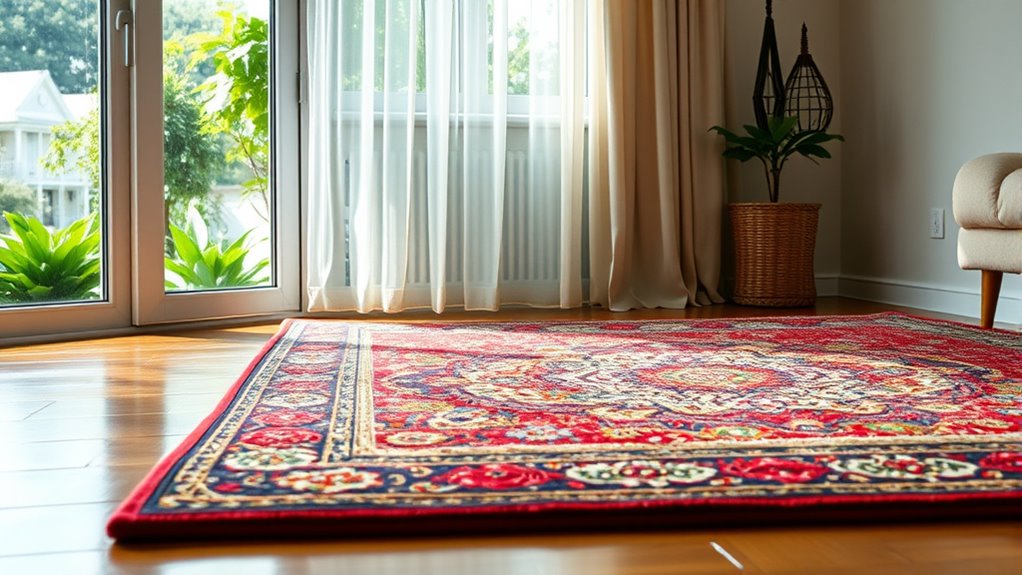
To keep your home fresh during the monsoon, consider placing rugs in areas with good air flow. This helps prevent moisture buildup and mold growth. Improving air circulation around your space is key to maintaining a healthy, comfortable environment. Additionally, elevating rugs slightly off the ground can aid in proper drying and airflow, further protecting your home from humidity-related issues asset division impacts financial stability. Ensuring proper ventilation techniques can significantly reduce the risk of dampness and prolong the life of your rugs. Using HEPA filtration devices to improve indoor air quality can also help in reducing airborne moisture and allergens that contribute to mold growth. Incorporating strategic data-driven marketing strategies can also help promote your home care solutions effectively.
Strategic Rug Placement
Have you considered how strategic rug placement can protect your home during the monsoon season? Proper placement minimizes exposure to excess moisture and reduces issues like rug color fading and mold growth. Keep rugs away from windows and direct sunlight to prevent fading. Elevate rugs on moisture-resistant pads to improve airflow and prevent dampness. Regularly rotate and reposition rugs to ensure even wear and avoid pet hair buildup in one area. Avoid placing rugs in low-traffic or damp zones, like basements or near doors prone to water splashes. This helps maintain rug integrity and cleanliness. Proper placement and ventilation are key to keeping your rugs fresh and dry during humid months.
- Avoid direct sunlight to prevent rug color fading
- Elevate rugs on moisture-resistant pads
- Rotate and reposition regularly
- Keep away from damp or water-prone areas
- Regular pet hair removal improves longevity
Enhance Air Circulation
Ensuring proper air circulation is essential for keeping your home dry during the monsoon season. To optimize airflow, position rugs away from walls and avoid clutter that blocks vents. Use natural ventilation systems, like opening windows during dry spells, to promote fresh air movement. Installing exhaust fans or ceiling vents can further improve airflow, reducing humidity levels inside your home. Keep doors open when possible to facilitate cross-ventilation, which helps dry out moist air. Regularly adjust window screens to prevent dust buildup that can impede airflow. Proper placement of rugs in well-ventilated areas ensures they stay dry and mold-free. By focusing on airflow optimization and utilizing effective ventilation systems, you protect your rugs and maintain a healthier indoor environment during rainy months.
Using Dehumidifiers and Moisture Absorbers
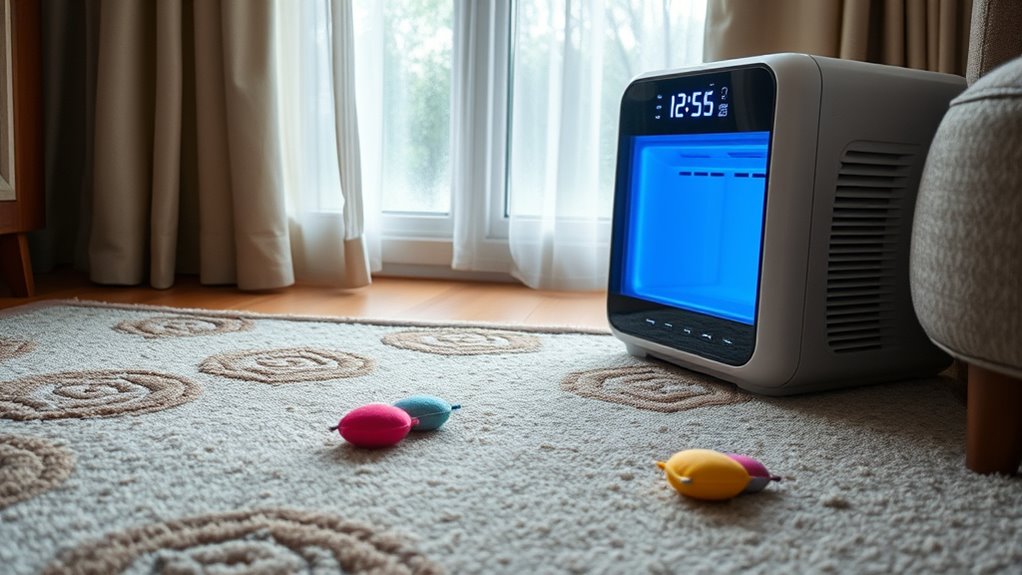
During the monsoon season, using dehumidifiers and moisture absorbers can make a significant difference in maintaining a comfortable and mold-free home. Set your dehumidifier to ideal dehumidifier settings to effectively control humidity levels without over-drying the air. Choose moisture absorber types like silica gel, activated charcoal, or calcium chloride, which target excess moisture efficiently. Regularly empty and replace moisture absorbers to keep them functioning at their best. Using these tools helps prevent mold growth on your rugs and other textiles, keeping your home fresh and safe.
- Adjust dehumidifier settings based on humidity levels
- Use moisture absorbers in closets and corners
- Replace moisture absorbers regularly
- Keep doors and windows closed when using dehumidifiers
- Monitor humidity with a hygrometer to maintain ideal levels
Choosing the Right Rug Materials for Humid Climates

Choosing the right rug materials can substantially reduce moisture problems in humid climates. Opt for materials with high durability, such as wool or synthetic fibers like nylon and polyester, which withstand moisture without deteriorating quickly. These materials resist mold and mildew better than natural fibers like jute or sisal, which can absorb excess humidity. Additionally, consider how the color will hold up; darker shades tend to show less fading over time, especially in humid conditions where sunlight and moisture can accelerate color loss. Selecting rugs made from sturdy, moisture-resistant materials helps maintain their appearance and structural integrity during monsoon season. Proper material choice ensures your rug remains vibrant and durable, even in the most humid environments.
Preventing Mold and Mildew Growth

To prevent mold and mildew from taking hold in your home, it’s essential to control moisture levels and promote proper airflow. Keep rugs dry by using dehumidifiers or fans, especially during humid weather. Regularly inspect your rugs for signs of mold and treat affected areas promptly. Eco-friendly treatments like vinegar or baking soda work well for DIY mold prevention and are safe for your family and the environment. Guarantee good ventilation in rooms with rugs to discourage moisture buildup. Avoid placing rugs in damp areas and consider elevating them on rug pads for airflow. To keep mold at bay, clean spills immediately and wash rugs periodically with mild, eco-friendly detergents. These simple steps help safeguard your rugs during the rainy season.
Seasonal Storage and Long-term Care Strategies
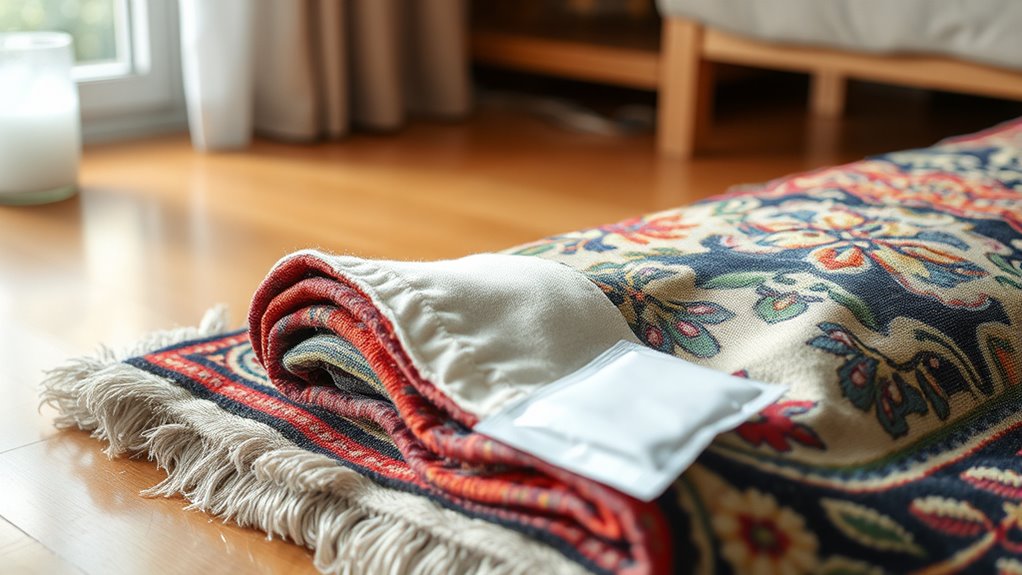
Proper seasonal storage and long-term care are essential to keep your rugs in top condition year-round. When storing rugs, verify they are clean and completely dry to prevent mold and pest issues. Roll them with the pile facing inward and wrap them in breathable fabric, avoiding plastic that traps moisture. Store in a cool, dry, and dark environment to protect antique rugs and preserve their value. To prevent color fading, keep rugs away from direct sunlight and fluctuating temperatures. Regularly check on stored rugs, unroll them periodically to inspect for pests or damage, and air them out if needed. Implementing these strategies helps maintain the rug’s vibrancy, ensures antique preservation, and prolongs the lifespan of your treasured pieces.
Frequently Asked Questions
How Often Should I Rotate My Rug During Humid Seasons?
You should rotate your rug every few months to maintain its appearance and prevent uneven wear. This regular rug rotation frequency helps distribute foot traffic and exposure to sunlight evenly, which is essential for seasonal rug maintenance. During humid seasons, consider increasing the rotation frequency to prevent moisture buildup and mold growth. By staying consistent with rug rotation, you guarantee your rug stays clean, dry, and in good condition year-round.
Are There Specific Cleaning Agents Best Suited for Humid Environments?
They say “Prevention is better than cure,” and that applies to cleaning agents in humid environments. For your rugs, choose gentle, mold-resistant cleaning agents that prevent moisture buildup. Avoid harsh chemicals that can damage fibers or trap humidity. Opt for natural or specially formulated rug cleaners designed for humid conditions. This proactive approach keeps your rugs fresh, mildew-free, and looking their best, even in the dampest seasons.
Can Rug Pads Help Prevent Moisture Damage?
Rug pads can definitely help prevent moisture damage by providing a barrier between your rug and the floor. The rug pad benefits include improved airflow, which reduces trapped moisture and mold growth. Using moisture prevention techniques like breathable pads or those with moisture-resistant properties enhances protection in humid environments. This way, you keep your rug dry, fresh, and in good condition longer, especially during humid summers when moisture issues are more prevalent.
How Do I Identify Early Signs of Mold or Mildew on Rugs?
To identify early signs of mold or mildew on your rugs, look for musty odors and discoloration, especially in hidden areas. Check for fuzzy or slimy patches, which indicate mildew signs. Regularly inspect your rugs to catch mold prevention issues early. If you notice any of these signs, improve airflow and reduce humidity around your rugs to prevent mold from spreading. Acting quickly helps protect your rugs and maintain a healthy space.
What Are Eco-Friendly Options for Moisture Absorption?
If you think moisture absorption is just a minor concern, think again—it’s the key to avoiding mold disasters! You can go eco-friendly with natural desiccants like bamboo charcoal, which absorbs humidity without harmful chemicals. Place these in your rug area, and they’ll work tirelessly, drawing out moisture naturally. Not only are they safe for the environment, but they also help keep your rugs fresh and mold-free all summer long.
Conclusion
By following these simple tips, you can turn your rug into a fortress against the relentless humidity of monsoon. Imagine your rug standing tall and pristine, as if it’s invincible, despite the muggy chaos outside. Don’t let mold and mildew take over your home’s centerpiece—arm yourself with proper care, and you’ll keep your rug looking brand new forever. With a little effort, your rug can defy the monsoon and stay stunning year-round!
